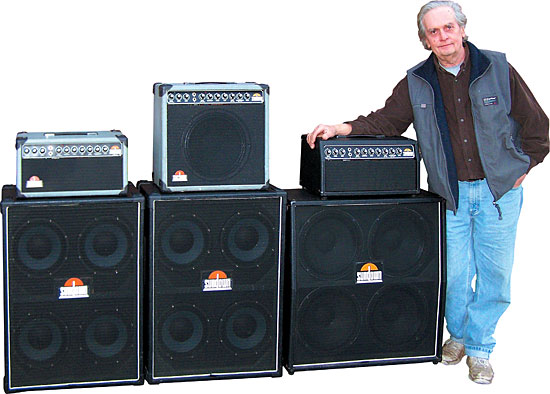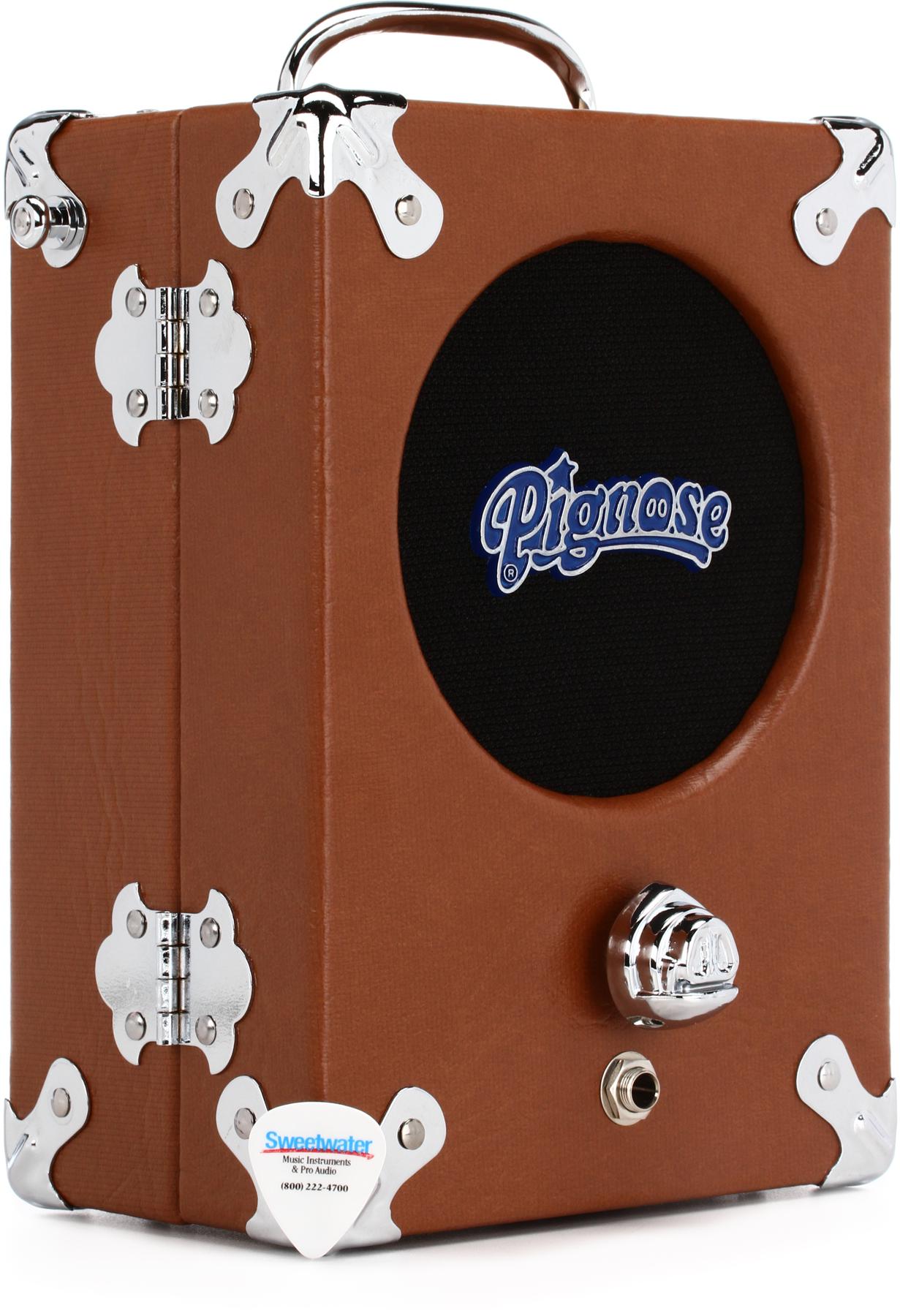The beloved Pignose 7-100 amplifier, was conceived, invented, and patented by Richard Elund and Wayne Kimbell.
They built a low watt amplifier inside a wooden English Leather Cologne box that distorted like all get out.
Impressed with this amp, Terry Kath took their idea to the Summer NAMM show in 1973. In the style of P.T. Barnum, Kath marketed it as The Legendary Pignose Amplifier. A star was born. The first year sales were over 50,000 units.
Pignose was THE first portable, battery-powered amplifier made specifically for guitar. It sounded like an over-driven Marshall 50 stack, but could be put on a guitar strap and slung over your shoulder.
The amp had that same gritty, dirty distortion of refrigerator-sized amps, but only pumped out 3 to 5 watts and weighed in at around 5 pounds! The Pignose represented The Counter-Culture thumbing their nose at the status quo of the day. Namely, when it comes to amplifiers, bigger is better.
The popularity of the Pignose soared. It was cute, with its one pig nose volume knob and tan vinyl covering. In addition, it was not expensive. It was originally priced at $79.95. Due to manufacturing costs, the price jumped to $159.95.
However, it is once again selling for $79.95. Clapton, Joe Walsh, Zappa, and Led Zeppelin used the Piggy for recording. The Eagles joked about having a wall of Pignose amps in concert.
The origin of the name is questionable and may have its origin in a drug-induced conversation.
The amp looked like a small valise. The Pignose was a 5” speaker, mounted in a hinged box that contained a solid-state battery powered amplifier and six AA batteries. The box can be used for storage as well. The only control is for volume; however, tone can be controlled by opening or closing the box. When the Pignose is un-hinged, the tone turns into screaming treble. A closed cabinet provides more midrange and bass. By having a friend rapidly open and close the amp, it can produce a wah-wah type sound.
The amp comes with a pre-amp output jack on the back allowing it to overdrive a larger amp. To emphasize the pig-nose joke, a molded metal knob that bore (or boar) resemblance to a pig’s snout was used as a volume control. The amp was covered in tan vinyl to give it the appearance of pigskin.
By 1974, Chicago’s accountant purchased the rights to Pignose Industries and held on until ownership passed. In 1985, Howard Chatt purchased the company and has been running it ever since under the name Pignose-Gorilla. (There was a budget line of low powered solid-state amplifiers under the brand name Gorilla.)
Elund and Kimbell are also responsible for the design of two other Pignose Industries products. These are the Hog 20 guitar amp and the Hog 30 bass guitar amp. Both are powered with rechargeable batteries.
I am not certain who designed the Pignose 30/60 amplifier. This was Pignose Industries first attempt at a larger amplifier, which was offered for sale in around 1977. The 30/60 put out a respectable 30 watts RMS and 60 watts peak power into a 12” Eminence speaker. The advertising states it goes from clean to dirty. Most reviews emphasize its distorted tone.
In 1997, Pignose Industries introduced a tube amplifier, The Pignose G40V. It was designed by Dennis Kager to have a similar schematic to a Fender Bassman. This amplifier was among the first to be manufactured in China, perhaps accounting for some criticisms and lack of acceptance. As of now, many guitar and bass amplifiers that carry famous USA and European trade names are being exported from China and have gained acceptance. This was not true in 1997.
The G40V had a tube compliment of twin 6L6 power tubes and three 12AX7 preamp tubes. Like many Fender amplifiers, the rectifier was solid state. It cranked out a very loud, 40 watts.
Unlike the Bassman, the G40V came with a preamp volume and master volume control. Like the Bassman, it had treble, middle, bass and presence potentioments. There was no standby switch. The stock 8 ohm, 10” speaker was rated at 80 watts. The tube sockets were ceramic, which was a very unusual feature for a low priced amplifier.
The amp was originally offered at $199 and as the years went on the price got up to $329. This was all housed in a 14” X 9” X 11” package that weighed around 28 lbs. When played through a larger speaker cabinet, the bass and midrange perked up and gave this amp some bottom. It had speaker jacks for 4 or 8 ohms. Interestingly, the cabinet is very similar in size and shape to the one used for the 30/60.
A few years later Pignose furthered their adventure in tube amps by introducing the G60VR (60 watt valve with reverb) and the B100V (100 watt bass tube amplifier).
I have never seen the B100. I assume very few were manufactured. The G60VR was an improvement over the 40-watt model. It came with a 12” speaker, which provided more headroom. The tube compliment was similar, except it had an additional 12AX7 preamp tube. The reverb was a plus. The tolex covering was black and thicker than the tan vinyl on the G40V.
 |
| Dennis Kager |
Kager launched his own brand called Sundown Amplifiers, which had a brief following. He was the force behind Reverend Amps. He has consulted for Fender, Yamaha, Mesa Boogie, Tone King, and Soldano. Kager runs an electronic repair company in New Jersey known as Central Jersey Music Service.
When my Pignose G40V was experiencing an unusual hum, my local tech spoke directly with Mr. Kager who resolved the problem. He was very impressed to speak to the man that modified amplifiers for the Allman Brothers, Bruce Springsteen, Peter Frampton, Rick Derringer and many others.
Pignose Industries venture into tube amplification lasted for about ten years. Their corporate action dictated they concern themselves only with solid-state amplifiers.
They have since offered a few new models of guitar amplifiers; some housed in a cabinets very similar to the G40V.
The original Legendary Pignose 7-100 is still the company’s mainstay. Over the years, it has indeed become legendary.













Tidak ada komentar:
Posting Komentar